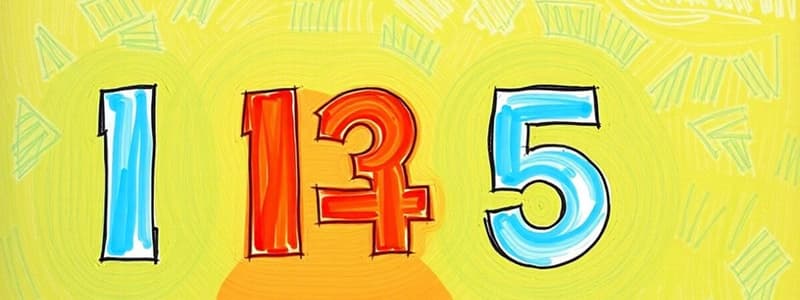Podcast
Questions and Answers
Which term describes a number that is smaller than another number?
Which term describes a number that is smaller than another number?
- Greater than
- More than
- Equal to
- Less than (correct)
When comparing the numbers 3 and 5, which statement is true?
When comparing the numbers 3 and 5, which statement is true?
- 3 is less than 5 (correct)
- 3 is greater than 5
- 3 is equal to 5
- 3 is more than 5
Which of the following is a correct way to express that two numbers are identical?
Which of the following is a correct way to express that two numbers are identical?
- Not equal to
- Equal to (correct)
- Less than
- More than
If a child has 7 apples and another has 4 apples, how can we compare these amounts?
If a child has 7 apples and another has 4 apples, how can we compare these amounts?
Which phrase would you use to show that 2 is smaller than 2?
Which phrase would you use to show that 2 is smaller than 2?
Flashcards
More than
More than
If one number is bigger than the other, we say it is more than the smaller one.
Less than
Less than
If one number is smaller than the other, we say it is ** less than ** the bigger one.
Equal to
Equal to
If two numbers are the same, we say they are equal to each other.
Comparison symbols
Comparison symbols
Signup and view all the flashcards
Comparing numbers
Comparing numbers
Signup and view all the flashcards
Study Notes
Introduction to Comparing Whole Numbers (up to 10) for Kindergarten
- Comparing numbers helps children understand quantities and relationships.
- It forms the foundation for later math concepts like ordering, sequencing, and addition/subtraction.
- Kindergarteners need concrete manipulatives and visual aids to grasp these abstract concepts.
Visual Aids and Activities
- Use objects like counters, blocks, or toys to represent numbers.
- Showing 5 blocks and 3 blocks side-by-side lets the child visualize which is more.
- Drawing pictures of the items being compared is also useful.
- Using fingers can be effective for comparing numbers up to 10, as this is a common reference. Illustrate counting hands
Comparing Numbers Using Terms
- "More than": Introduce the concept that one set has more items than another. A visual will help. For example, if there are 7 apples and 4 bananas, say "There are more apples than bananas."
- "Less than": Explain that one set has fewer items than another. Use the same apple/banana example above to say "There are less bananas than apples."
- "Equal to": Introduce the concept that two sets have the same number of items. If there are 5 oranges and 5 grapes, say "There are equal oranges and grapes". This is an essential component to ensure children grasp equal values properly. Visualisation is key.
Activities and Example Questions
- Use simple comparison activities, like comparing two groups of objects (e.g., 3 buttons and 5 buttons).
- Ask questions like: "Which group has more?" or "Which group has less?"
- Encourage children to point to the group that is more or less.
- Ask questions that require them to formulate answers using the terms.
Practical Application (Example)
- Place 6 red counters and 8 blue counters on a table.
- Ask the children: "Are there more red counters or blue counters? How many more?".
- Encourage the children to count both groups aloud.
- Guide them to answer using the correct vocabulary ("There are more blue counters than red counters").
Key Concepts for Kindergarten (Comparison Introduction)
- Identifying and using the vocabulary "more than", "less than", and "equal to".
- Using pictorial or concrete representations for comparisons.
- Matching quantities to numbers up to 10.
- Recognizing numbers as representations of quantities.
Example Visual (Image)
(Image cannot be displayed here, therefore cannot be included).
- A suggested image could be two rows of objects, each with a different amount like 3 apples and 5 oranges, with the labels "more than", "less than", and "equal to" clearly mentioned. The visual should use a clear visual cue.
Further Development
- Introduce number lines to help visualize numerical relationships.
- Progress to comparing numbers abstractly.
- Introduce numerical symbols (<, >, =) to represent comparison.
Studying That Suits You
Use AI to generate personalized quizzes and flashcards to suit your learning preferences.
Description
This quiz focuses on the essential skills of comparing whole numbers up to 10, aimed at kindergarten students. It highlights the importance of visual aids and activities in helping children understand quantities and relationships. Teachers and parents can utilize this knowledge to enhance children's foundational math skills.




